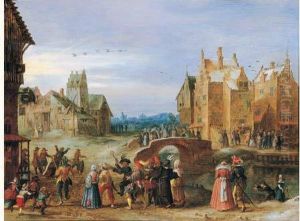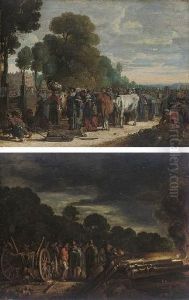Govert Jansz. Paintings
Govert Jansz, also known as Govert Jansz Vischer, was a Dutch Golden Age artist, though not as widely recognized as some of his contemporaries. Born in 1586, Govert Jansz worked during a period characterized by a booming Dutch economy and a great demand for art. This period saw the rise of many famous Dutch painters, such as Rembrandt and Vermeer, who are celebrated for their contributions to art history.
Jansz's life and work are not as well-documented as those of the leading figures of the era, and consequently, details about his biography are sparse. What is known is that he was active in the city of Haarlem, which was a significant artistic center in the Netherlands during the 17th century. Haarlem was home to the Guild of St. Luke, an association of painters, which Jansz may have been a member of, as it was common for artists of the time to join local guilds.
Despite the limited information about his personal life, Govert Jansz would have been trained in the traditions of Dutch painting, which emphasized realistic depictions, attention to detail, and the use of light and shadow. His works would likely have included the popular genres of his time, such as portraits, landscapes, still lifes, and genre scenes depicting everyday life.
Jansz's death in 1666 came at the end of the Dutch Golden Age, which is generally considered to have concluded around the mid-17th century. Although Govert Jansz may not have achieved the fame of his peers, his life and works would have contributed to the rich tapestry of Dutch art during one of its most flourishing periods. Today, any surviving works by Jansz would be of interest to art historians and collectors who specialize in the Dutch Golden Age.

